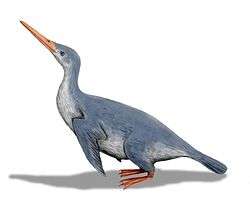Waimanu
| Waimanu Temporal range: Paleocene, 60–58 Ma | |
|---|---|
 | |
| Scientific classification | |
| Kingdom: | Animalia |
| Phylum: | Chordata |
| Class: | Aves |
| Order: | Sphenisciformes |
| Genus: | Waimanu Slack et al., 2006 |
| Species | |
| |
Waimanu is a genus of early penguin which lived during the Early Paleocene soon after the Cretaceous–Paleogene extinction event. Its discovery helped support the idea that the radiation of the Neoaves (including most modern birds) either took place before the extinction of the non-avian dinosaurs, or extremely rapid in geological terms immediately after. DNA-studies, e.g., the extensive one by Hackett and colleagues, seem to indicate the latter.[1] While it was a very early member of the sphenisciformes (the order that included modern Penguins), Waimanu was flightless like all modern penguins. Though its wing bones do not show the extreme specializations modern penguins have for an aquatic lifestyle, it does seem adapted for wing-propelled diving, and may have resembled a flightless loon in body shape and maybe the great auk in its manner of locomotion. DNA sequence analyses and anatomy argue for a close relationships of penguins and loons, the former lineage specializing for wing-propelled and the latter for foot-propelled diving.
Discovered in the Kokoamu Greensand near the Waipara River, in Canterbury, New Zealand, in 1980, the name Waimanu comes from Māori for "waterbird". Two species are known, Waimanu manneringi from the Middle Paleocene about 60 million years ago (mya) and Waimanu tuatahi from the Late Paleocene, perhaps 58 mya.[2]
References
- ↑ Hackett, S.J. et al., (2008). "A Phylogenomic Study of Birds Reveals Their Evolutionary History." Science, 230(27): .
- ↑ Slack, K.E., Jones, C.M., Ando, T., Harrison G.L., Fordyce R.E., Arnason, U. and Penny, D. (2006). "Early Penguin Fossils, plus Mitochondrial Genomes, Calibrate Avian Evolution." Molecular Biology and Evolution, 23(6): 1144-1155. doi:10.1093/molbev/msj124 PDF fulltext Supplementary Material